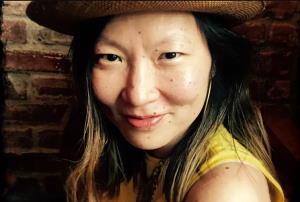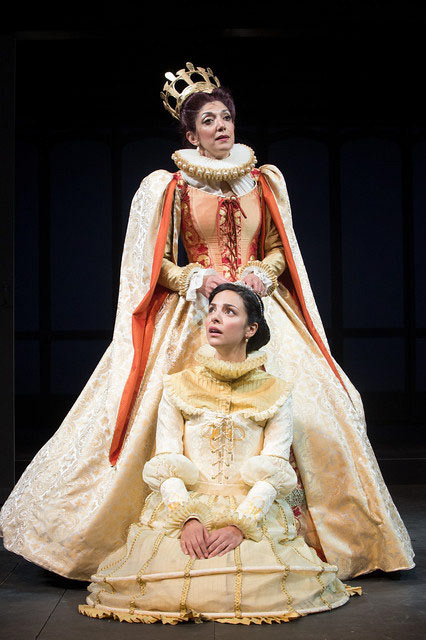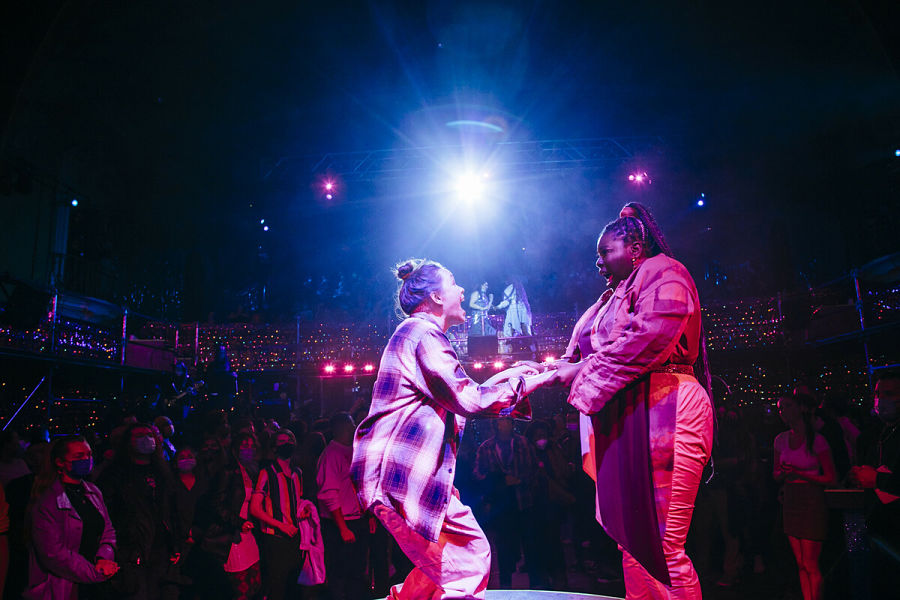You can be forgiven if you’ve never noticed this, but the popular idiom “head over heels,” which we use to describe the topsy-turvy bewilderment of falling in love, makes not a lick of sense, as our heads are usually quite contentedly over—or, when we’re sleeping, merely parallel to—our heels. Indeed, the phrase apparently originated in the 14th century as “heels over head,” to describe cartwheels or somersaults, but somewhere along the line got reversed, because “heels over head” just isn’t very catchy. (If I had to guess, I’d pin this linguistic reversal on a variation of ablaut reduplication, a fancy way of explaining the way phrases with repeated vowels typically sound best in English.)
And so we are gifted not only with this oddly counterintuitive phrase, but with the Go-Go’s banger of the same name, and now a whole stage musical—not a jukebox tuner per se, but a braiding of Sir Philip Sidney’s Elizabethan pastoral Arcadia with the song catalogue of the New Wave quintet. Originally conceived by Jeff Whitty and staged at Oregon Shakespeare Festival, Head Over Heels was reworked by James Magruder and director Michael Mayer for a brief but splashy Broadway run in 2018, and now it’s making its L.A.-area debut in a slimmed down, immersive staging at Pasadena Playhouse, to a rave review in the L.A. Times, where critic Charles McNulty hailed it as “an exuberant reopening” full of “free-flowing festivity.”

That was absolutely the intent of co-directors Sam Pinkleton (he/him) and Jenny Koons (she/her), two theatremakers brought on by Playhouse artistic director Danny Feldman to make the return of in-person theatre something distinctively memorable. As Pinkleton put it to me a few weeks ago from the midst of rehearsals, “I kind of am only interested in theatre that is also an event, where, when you leave, if you think you just saw a concert or you think you just saw a play or you think you just went to a party—you did, right?”

That’s why Pinkleton and Koons have put risers on the Playhouse’s proscenium stage and a dance floor over the orchestra, so that audiences can have various “access points” and the actors can rove freely around them.
“A third of the audience will be standing,” said Koons. “And our cast of eight amazing unicorn performers from so many different artistic backgrounds will be all around the space at all times. We want this to be accessible to everyone: the long-term Pasadena Playhouse subscriber, and the 17-year-old who’s obsessed with the Go-Go’s who’s never set foot in the theatre, and not favoring one over the other, but really saying, as an open invitation: Do you want to stand and dance with your friends? Great. Do you want to sit in a proper seat with a number ticket? Great. The onus is on us to create an equal experience for all of those people.”

This is true to the immersive experience Whitty originally had in mind for the piece’s 2015 debut at Oregon Shakespeare Festival under director Ed Sylvanus Iskandar (replaced at the last minute by OSF artistic director Bill Rauch). By the time the piece made it to Broadway, Whitty had been replaced on book-writing duties by Magruder, and Mayer’s direction, though lively and cheeky, favored a traditional proscenium staging. Though Pinkleton and Koons told me they don’t know much about the piece’s rocky creative history—“We licensed it like it’s Annie,” quipped Pinkleton—it is striking how close to the piece’s original vision their staging seems to be hewing.
Maybe it’s because the very idea of an Elizabethan Go-Go’s musical lends itself to a certain kind of creative experimentation. Or it could be that the story, in which gender- and star-crossed lovers of various generations venture in a forest and discover unsettling but exciting new truths about themselves, invites a certain Dionysian fluidity. Whereas the king and queen of Arcadia were played on Broadway by Jeremy Kushner and Rachel York, in Pasadena they’re assayed by Lea DeLaria and Alaska Thunderfuck 5000. And Pythio, the Oracle played by the trans actor Peppermint on Broadway, is played in Pasadena by Freddie, a musician and drag performer.
“The thing that attracted us to the characters,” said Koons, “is that it’s the story of people who go on a journey and find out that there was more inside of them than they knew, that they were more expansive than they ever imagined. That was the most exciting part to us about, why do this show now—that for the 20 months we’ve all been on this journey, and we’re all reemerging as different people than we were before.”
The key to the show’s form might be even simpler than that: The tunes are slamming.
“The Go-Go’s music is just totally, unselfconsciously joyous, abundant, and hilarious,” Pinkleton effused. “The songs are fucking great, and that is not always the case when you’re making musical theatre. It’s almost never the case, I would argue.”

The songs don’t just hit one register, he was quick to add. “They also speak to something deeper—they hit you in the guts in a way that, for me, at least, can’t so easily be picked apart to be about one thing or another. It’s what I like about dance floors. You know what the dance floor is about? Everything.”
And nothing. As Jeff Whitty once told me, quoting Sir Philip Sidney: “The book is ‘but a trifle, and that triflingly handled.’ We will do our best to treat the story as its author intended.”
A bit like the phrase “head over heels,” it all makes a kind of upside-down sense.
Rob Weinert-Kendt (he/him) is the editor-in-chief of American Theatre. rwkendt@tcg.org
Creative credits for production photos: Pasadena Playhouse production directed, choreographed, and conceived by Jenny Koons and Sam Pinkleton, with music direction by Kris Kukul, scenic design by David Meyer, costume design by Hahnji Jang, lighting design by Stacey Derosier, and sound design by Danny Erdberg and Ursula Kwong Brown; Oregon Shakes production directed by Ed Sylvanus Iskandar and Bill Rauch, with music supervision, orchestrations, and arrangements by Carmel Dean, choreography by Sonya Tayeh, scenic design by Christopher Acebo, costume design by Loren Shaw, lighting design by Jane Cox, video design by Mark Holthusen, sound design by Kai Harada, and music direction by Garaldine Anello


